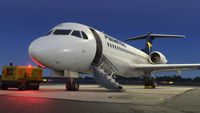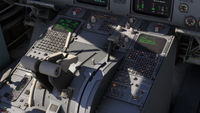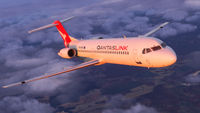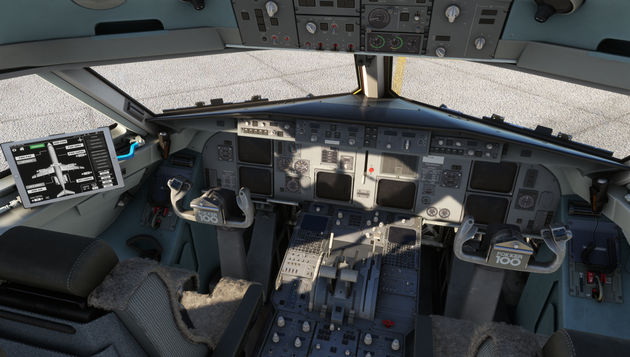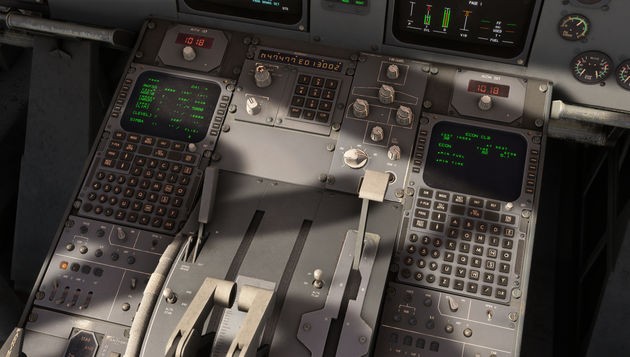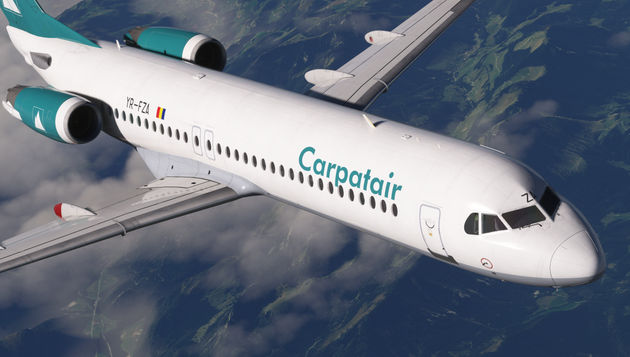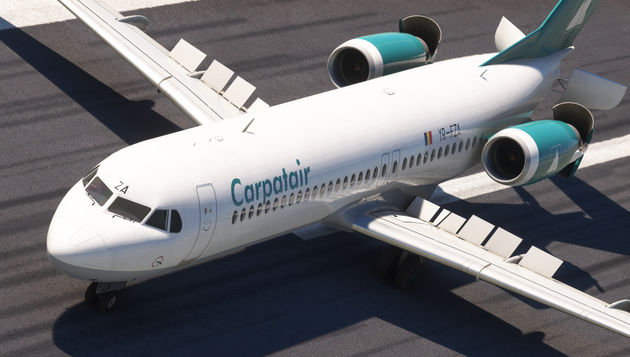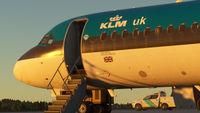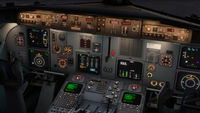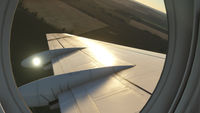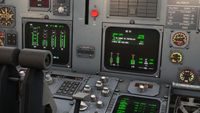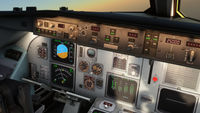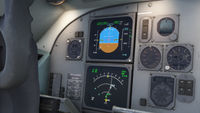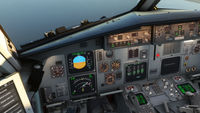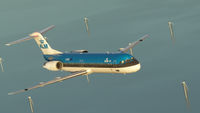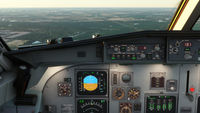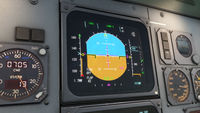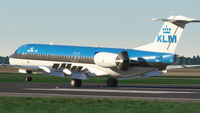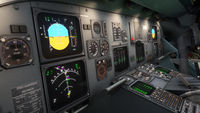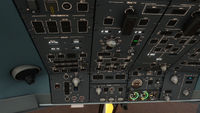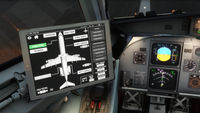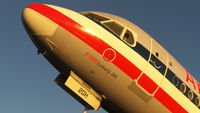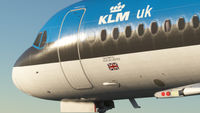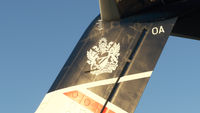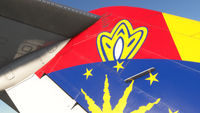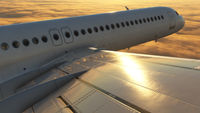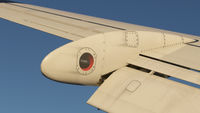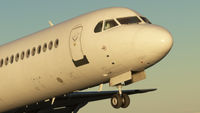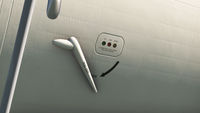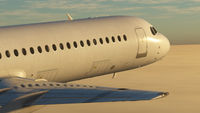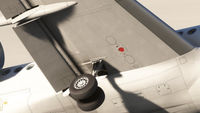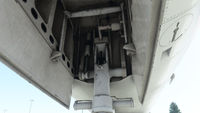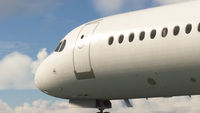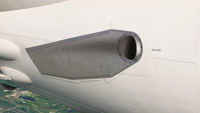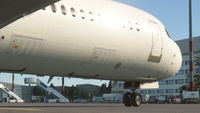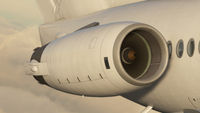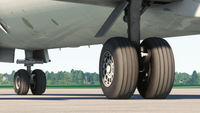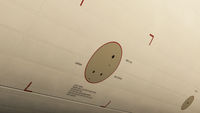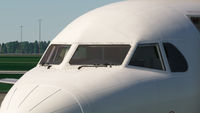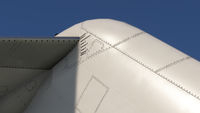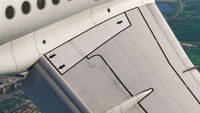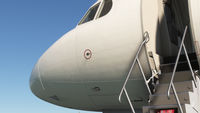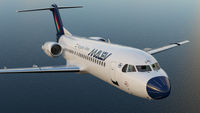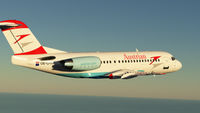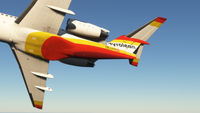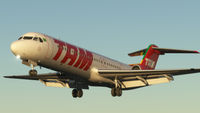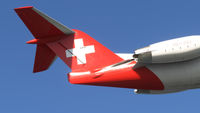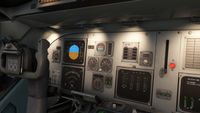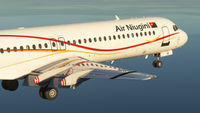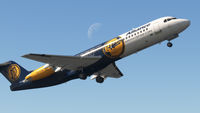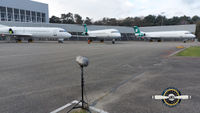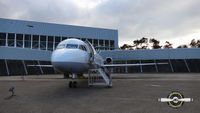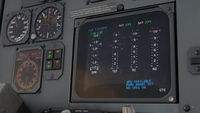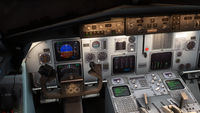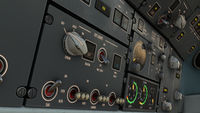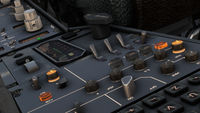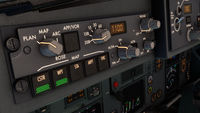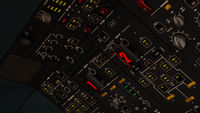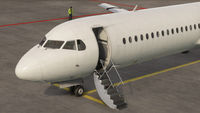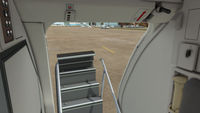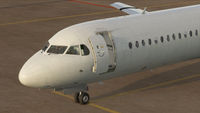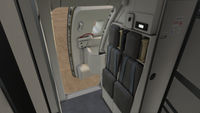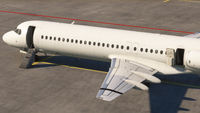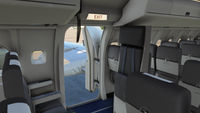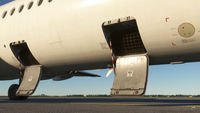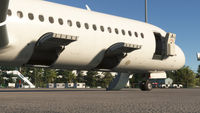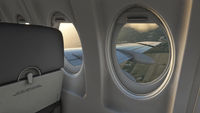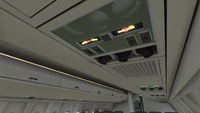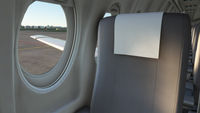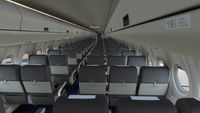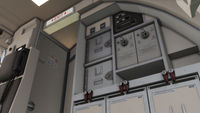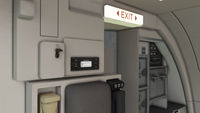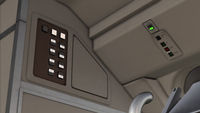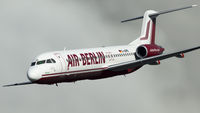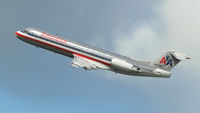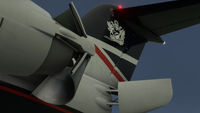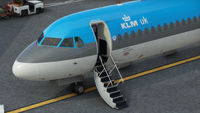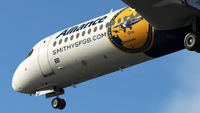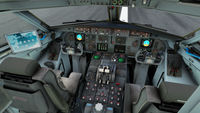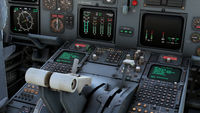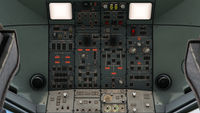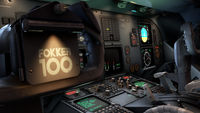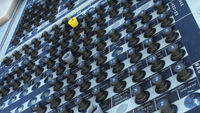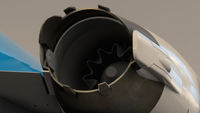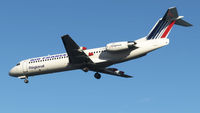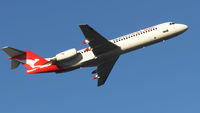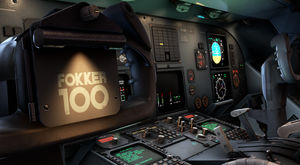06 November 2025
It’s been a while since we last shared news on our F70 and F100 Professional add-ons
Understandably, given how feature-complete and visually stunning the aircraft were already looking back in the summer, many of you have been wondering why it’s not yet been released.
Given that we have published some news covering some reasoning for the delay along with a general update. To read that please head here
And just to show how nicely things are shaping up here are some screenshots taken from the latest round of testing.
Just remains to say, thanks for your patience. The wait shouldn't be too much longer.
29 August 2025
With the release date getting ever closer for our F70 Professional and F100 Professional products, here is what is likely to be the final text-based in-development entry before we pull the TOGA levers, and accelerate to the pre-release coverage.
This month has been, and continues to be, an exceptionally busy time for us with F70 and F100 development. Project management is in full swing organising the abundance of moving parts within both projects. In just the last week alone, we have received at least one build from each of our coders, our flight model developer, our sound artist, and from each of our model, texture, and livery artists. Each of these builds requiring integrating into the aircraft package’s, which include the 5 variants and 2 simulators(!), before then being tested by our internal testing team to confirm the functionality of new features, any bug fixes, and to check for any newly introduced issues. With this ever moving jigsaw puzzle, its often difficult for us to find the time to write an in-development entry that is worth your time, however, we scheduled some time in earlier this week to provide a much requested update on recent developments.
An area which has recently seen the completion of coding is the Traffic Collision Avoidance System (TCAS), which is now generating TAs (Traffic Advisories) and RAs (Resolution Advisories) generated within the required conditions. Other aircraft in the proximity appear as a blue symbol on the EFIS ND with an altitude indication and a trend indicator. When an aircraft gets within 40 seconds of a potential collision, a TA is generated and the symbol changes to amber. When an aircraft gets within 25 seconds of a potential collision, an RA is generated and the symbol will changes to red. In the event of a possible collision, climb/descent indications will be presented on the PFD, and accompanied by aural alerts. The TCAS also has a functional above/below filter, allowing you to filter traffic that is above, below, or above and below your aircraft. This, as well as the various TCAS modes and the TEST functionality, are all located on the transponder panel on the pedestal, which as also recently been remodelled to more closely match the unit fitted to our reference aircraft.
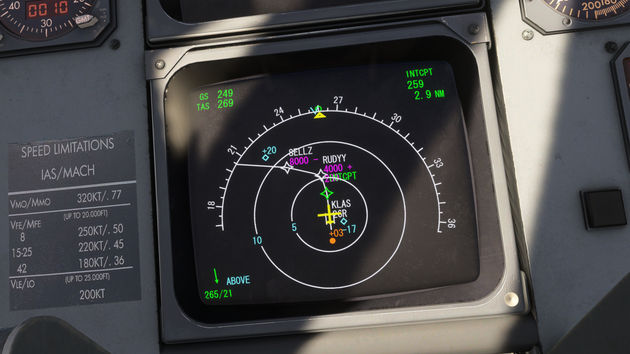
Another system which has been completed in recent weeks is the Weather Radar. Controlled via a mixture of controls on the EFIS Control Panel and the Weather Radar panel, the weather radar will display on the EFIS ND and provide an indication of the precipitation in front of the aircraft. The severity of the precipitation is indicated via a colour scale, with green being light precipitation, and red being heavy precipitation.
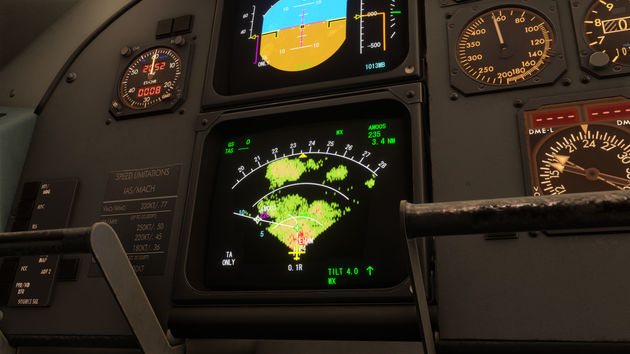
Just next to the captain’s EFIS ND is another newly added feature, the interactive speed flipchart. This popular feature from our other airliners has been added to the F70 and F100 and provides the all important takeoff and landing speeds for various flaps settings. Via an option on the EFB, the flipchart will either be automatically set to the aircraft’s current weight, or, the flipchart can be flipped through manually so you can find the correct weights for yourself.
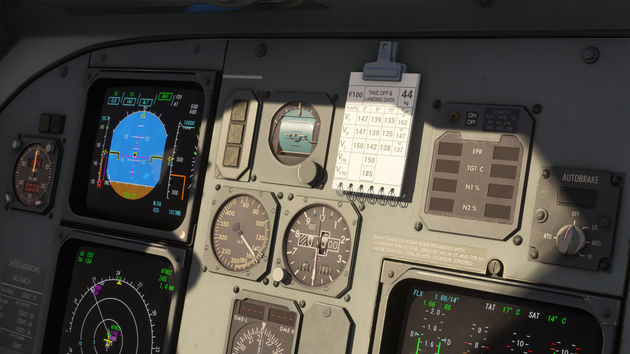
Briefly sticking on the theme of interactive items, our interactive paper checklists are also make a return! The F70 and F100 both have a chart holder located on the yoke – a perfect location for these checklists! The yoke also has an integrated light which can illuminate the checklist at night. These checklists can be cycled through via clickspots on the paper itself, and custom documents can also be imported.

Continuing with configuration options, we have now fitted each F70 and F100 livery with accurate equipment configurations based on extensive research of the real aircraft. Optional taxi lights, logo lights, and cockpit units of measurement will be set automatically based on the livery you select. A large selection of other options are also toggleable on the EFB, including Fast/Realistic IRS Alignment Times, pilot model visibility, Pilot Callout toggle, and even the visibility of the Sun Visors.
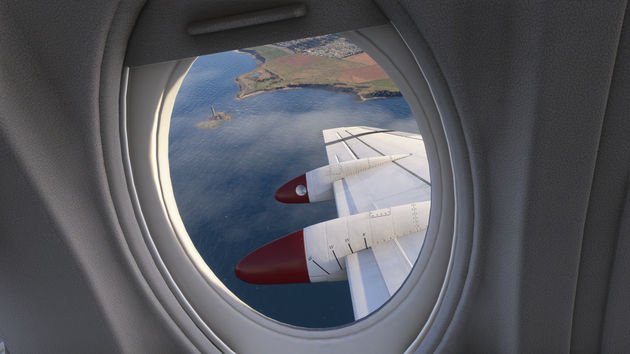
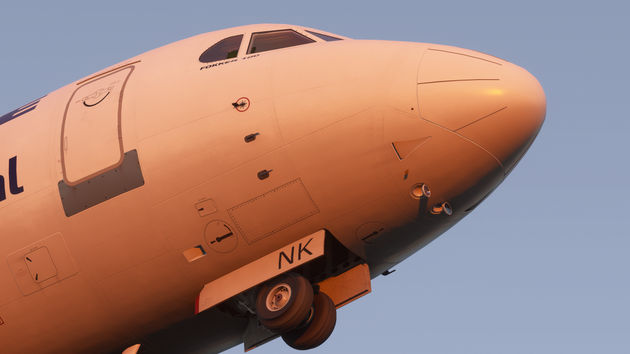
And whilst we’re on the subject of the EFB, we can also share a screenshot of our brand new EFB model. The EFB has turned into such an instrumental part of any flight simulation product, housing a variety of customisation options, fuel and payload controls, charts, checklists, and more. With it having so much use, we have created this brand new model with a slick black design. Two different mounts have also been modelled, a wall mount and a window mount.
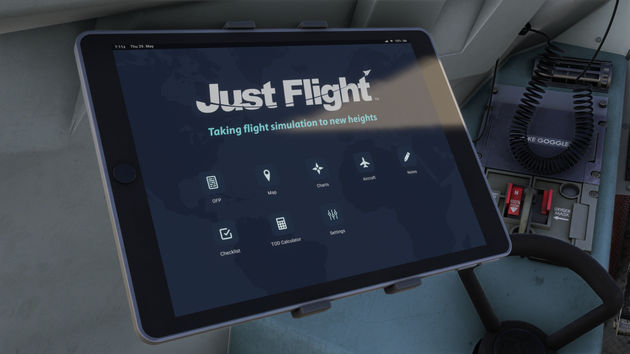
Moving aft into the cabin (we’ll let you discover how to open the cockpit door and retract the observer’s seat!) we have also recently added the remainder of cabin simulation. The cabin functionality has taken a further step up from our previous airliners, with functional cockpit to cabin, cabin to cockpit, and cabin to cabin calls via the handsets, functional ceiling call lights and various chimes and buzzes that can be heard when these calls are triggered.
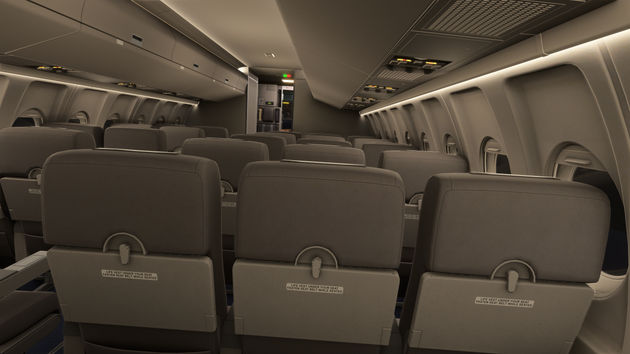
A fully functional cabin lighting panel is included on the rear wall of the forward galley and provides controls for the cabin lights. The lighting has now been fine tuned in all 5 variants (and in two simulators!), with each featuring side wall, ceiling, galley, emergency and standby lighting.
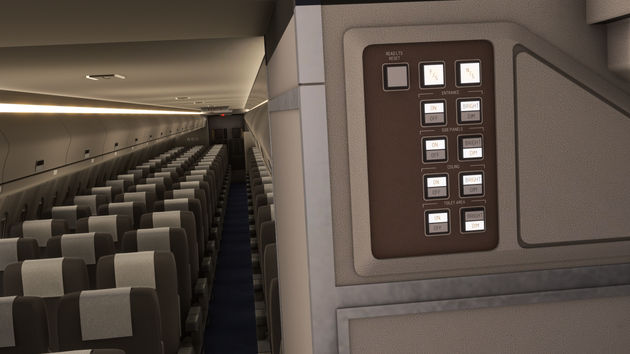
On the forward wall of the forward galley we also see the return of the Digital Music Player, now with expanded functionality which includes cabin announcement support. Cabin announcements for welcoming passenger on board, safety briefing, seat belts signs, or even flight delays can be triggered either manually from these panels, or automatically via the Auto Cabin Crew functionality.
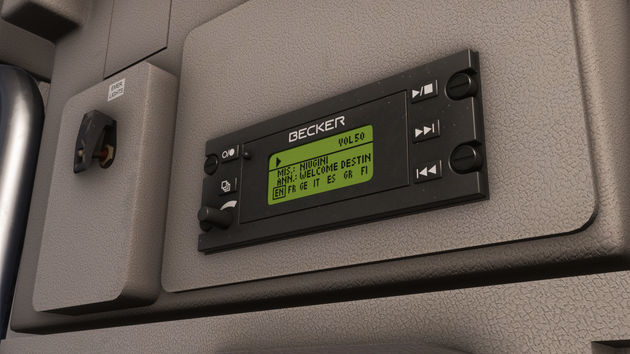
So far in this in-development update we have covered some of the tasks that have recently been completed by our development team. That begs the question of what tasks are remaining? Work continues to revolve around the complexities of the Automatic Flight Control and Augmentation System (AFCAS), Autothrottle System (ATS), and Flight Management System (FMS). With each of these systems being so interconnected to one another, and all together making up the heart of the aircraft, we have one of our coding team dedicated to working full time on them to ensure all three areas are where they need to be, from day one. We could write lengthy in-development entries just on the AFCAS, ATS and FMS alone, as they are some of the most complex systems to ever feature in a Just Flight aircraft, but we’d prefer to show you the logic in action in upcoming video content.
Another area that takes up a lot of time is ensuring that everything is accurately simulated. For example, the real world F70 and F100 do not support waypoints with upper and lower altitude constraints, so recently we have spent a lot of time convening with pilots to understand how the aircraft would react if it came across one of these waypoints, and exactly what they as a pilot would do. Naturally, a lot of the questions we have are so specific that they aren’t covered in the aircraft’s FCOMs, so maintaining a constant communication with the pilots on our testing team has been an instrumental part of the development process.
Other areas that are still in progress include the sound set. Work is actively ongoing, but as with all of these arts, they cannot be rushed. Just this week we have added the aforementioned cabin announcements and pilot callouts into the product, which are sounding great! The sound set promises to be one of our finest to date, and we will be sure to share a video or two with you once we are happy to show it off in full.
This has turned out to be another lengthy in-development update - thank you for reading this far! As we mentioned at the start, we anticipate this to be the last text-based in development update before we start to ramp up our pre-release marketing. Expect to see plenty of video content from us, and your favourite content creators as we run up to the release.
We are proud with what we have achieved so far with the F70 Professional and F100 Professional, and we can’t wait to share more.
03 July 2025
It’s time for a new F70 Professional and F100 Professional in-development update!
Since our last update, the team has been working around the clock to elevate both products to an entirely new level. We’ve been pushing boundaries, refining every detail, and setting a new benchmark for what Just Flight products can deliver. While this unwavering focus on development has meant fewer in-development updates than usual, we’re confident that what’s coming will more than justify the wait.
To give you a meaningful look at the products, we’re taking you along on a test flight from Salzburg to Brussels in the latest Beta build of the F100 Professional. Please note that this is still a work-in-progress, so some bugs and unfinished elements are expected - and we’ll even highlight a few along the way!
Upon loading into the aircraft, the first thing that stands out is the modelling and texturing. It’s certainly a very different visual to the analogue cockpits we are used to developing, but the mix of the curved CRT displays and analogue standby instruments, really scratches that itch of a quirky, 90s airliner at the beginning of the ‘Glass Cockpit’ revolution. The cockpit textures have been created using extensive reference photograph of the real aircraft, and include some customisable elements such as different taxi light configurations, and various panel and instrument differences between the F70 and F100.
The exterior textures have also been created using extensive photography of the real aircraft, with every rivet, screw and panel line painstakingly hand placed. The exterior looks particularly impressive in MSFS 2024’s walkaround mode!
The cabin is also an area that has been meticulously crafted, and just like the exterior, includes several different configurations for the F100. Different cargo and passenger door options are modelled on the exterior and interior, and are automatically assigned based on the chosen livery. The cabin modelling and texturing are complete now on both the F70 and F100, with some of the remaining work including the fine tuning of the cabin lighting, and integrating the various cabin to cockpit interactions.
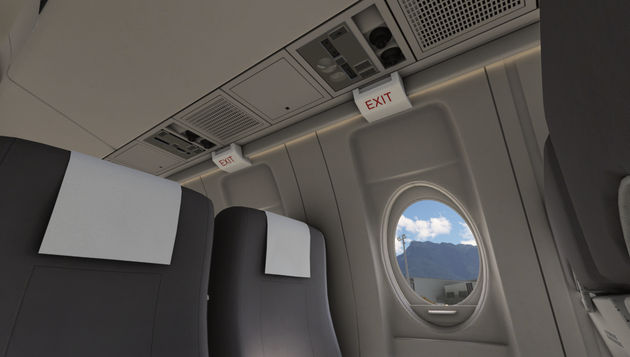
One area that has been a key focus for us during development is FPS/Performance. The optimisation process is still ongoing, but with our latest F100 Professional Beta build, we are seeing FPS figures that are within approximately 5% of the MSFS 2020 default 747 and 787. Of course FPS figures will vary from user to user, and will depend on PC specifications, the simulator used and the location in the simulator, so we can’t guarantee that you will be seeing the same FPS on your PC, but we hope this gives you a positive insight into the work we have put into this area. We encourage content creators to highlight the FPS on their systems when they are given access to the product for an unbiased, third-party opinion.
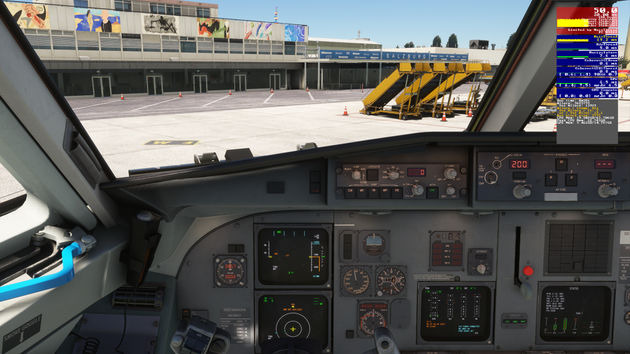
Once sat in the cockpit, electrical power can be applied to the aircraft and we can begin to work through the MSFS interactive checklists which house almost 300 individual items - over 250 of those items are to be completed prior to takeoff! Of course, most of these checklists are tests that are typically only carried out prior to the first flight of the day, but the checklists are all there and the associated systems logic will be included so that all of these checks can be completed in full. One remaining task on the system test front is the Annunciator Test, which involves a very specific, ordered illumination of all the cockpit annunciators. Fortunately, we have a slow motion video of this test recorded in the real aircraft, so we’ll be able to replicate this test with maximum accuracy.
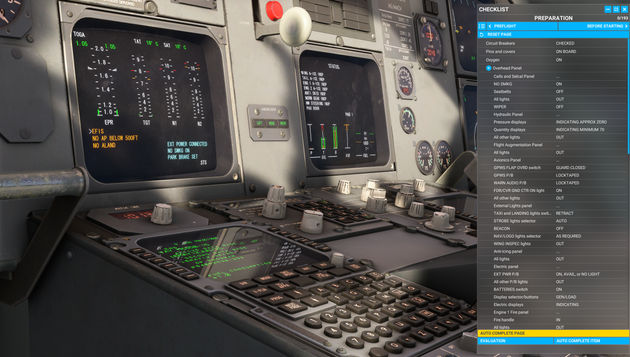
The Flight Management System (FMS) is complex, high-fidelity simulation in its own right. The FMS is entirely custom-coded and includes feature such as, IRS alignment (real time and fast align), manual IRS alignment adjustment, manual flight plan entry, automatic and manual navaid tuning, navigation and performance monitoring, custom waypoint creation, and Vertical Navigation (CLB, CRZ and DES). These are only just some of the features included with the FMS, and we’ll be sure dive deeper into these features in more depth in both the upcoming marketing content, as well as the Operations Manual.
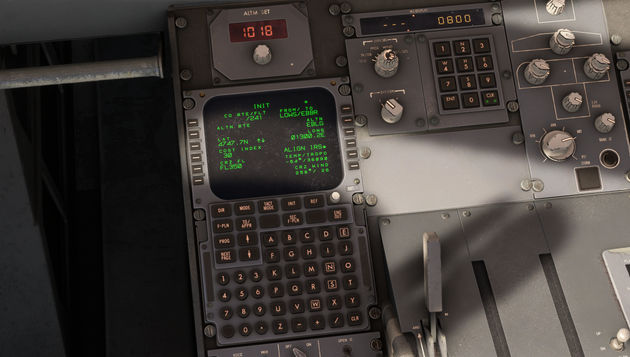
The FMS in the F70 and F100 is by far the most complex system we have ever developed for one of our aircraft. It’s the heart of the aircraft, with integration with the autopilot, flight model, EFIS displays and other systems. Due to this complexity, it’s naturally turned into the part of the aircraft that is taking the most time to develop, however, we do now consider the FMS to be feature complete, and our testing and development teams continue to, fine-tune, improve, and squash any remaining bugs ahead of the release.
Taxiing onto the runway, we get to perform something that we believe is unique to the F70 and F100 – Flaps 0 takeoffs. Although the aircraft can takeoff with Flaps 8 or Flaps 15, Flaps 0 is the standard takeoff flap setting that provides the best climb performance. The F70 and F100 have no slats, so with a Flaps 0 takeoff, the wing is in a fully clean configuration, with reliance placed on the aircraft’s thick wing and powerful engines.

Courtesy of the aircraft’s wing configuration, the aircraft has good performance at low altitudes, but will become sluggish at high altitudes, especially at higher weights and temperatures. As an example, if we take an F100 with Tay 620-15 engines operating at Maximum Takeoff Weight (MTOW) and taking off in ISA conditions from an airport at sea level, the aircraft should take 30 minutes and cover 156 nautical miles to reach 35,000ft. Based on recent tests in the simulator, we currently have the aircraft performing at 95% accuracy to these figures, which we are pleased with. Some phases of the climb profile are even closer to the elusive 100% accuracy, with other areas being closer to 95%, but this is one area of the product that continues to see improvements all the way up until release, so this accuracy will continue to improve.
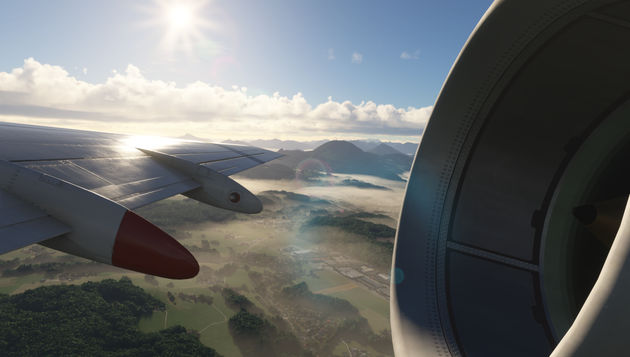
Climbing away from the mountainous backdrop, AP1, ATS, NAV and PROF modes are engaged on the FMP (Flight Mode Panel). AP1 is the master control for one of two Autopilot systems, ATS is the Autothrottle System which controls the throttles, NAV is the lateral navigation mode that ensure the aircraft follows the flight plan displayed on the Navigation Display, and PROF is the profile mode which is responsible for Vertical Navigation (VNAV). With these four modes engaged, they will work together to follow the lateral flight path as programmed in the FMS (and displayed on the Navigation Display), and will fly a vertical profile that respects any speed and altitude restrictions listed in the FMS.
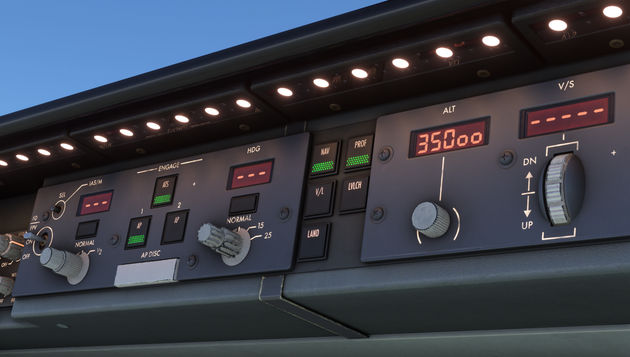
Whilst passing through 30,000ft, two alerts appear on the LH MFDU (Left-Hand Multi Functional Display Unit) indicating a high N1 speed in both engines. A checklist automatically opens on the RH MFDU (Right-Hand Multi Functional Display Unit) listing the necessary items that must be performed to rectify the issue. A cursor on the page can be cycled through each checklist item using an ADV (Advance) switch on the pedestal. Once a checklist has been completed, it will be automatically removed from the RH MFDU.
Whilst the engine N1 overspeeds aren’t an expected failure, they have proved a great opportunity to test the alerts, memo messages, and checklist system. From a testing perspective, feedback for this behaviour will now be written up and logged on our internal bug tracker for our development team investigate further. This will be good feedback for our development team, as the engine overspeeds were likely the result of some attempted improvements to the aircraft’s climb profile accuracy (as discussed earlier in this update). This is of course, is all a standard part of the development process, and the engine performance will be finalised ahead of the product’s release.
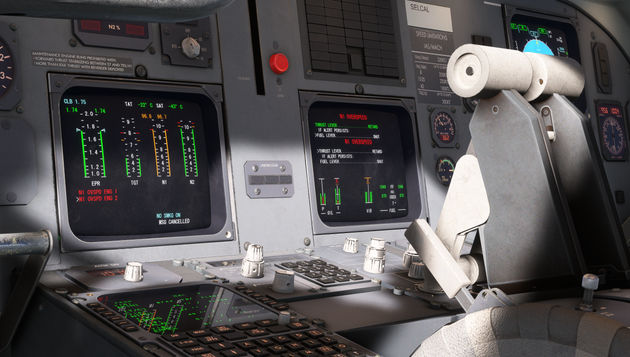
With the aircraft settled in the cruise, there usually isn’t much to do other than to listen to the sound of air rushing across the cockpit windows, and the engines and air conditioning working away in the background. Unfortunately, we can’t share sound through text and images, and although the sound set is actively in development, we aren’t at a point yet where we want to share it just yet. We will, however, have a Sound Overview video dedicated to the sound set ahead of the product’s release.
In case you missed it previously, you can read all about the sound recording session we had with the real aircraft last year
here
When approaching the T/D (Top Of Descent) point as displayed on the Navigation Display, a descent can be started in one of several ways. The simplest way is to preselect a new altitude in the ALTITUDE window on the FMP and pull the altitude knob. That will arm “DES” (Descent) mode and upon reaching the T/D point, the aircraft will smoothly pitch down and follow the calculated descent profile down to the preselected altitude.
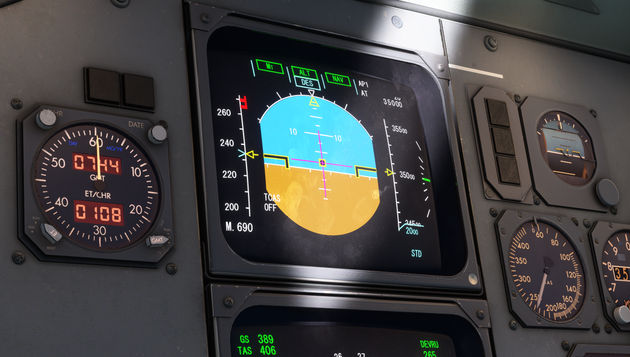
An alternative method of starting a descent is to use the IMM DES (Immediate Descent) feature through the FMS. Initially following the same procedure as previously listed to arm DES mode, an IMM DES option will become available in the top right field of the FMS F-PLN page. Pressing the LSK (Line Select Key) next to the IMM DES option will immediately start a descent at -1,000ft/min. Once in a descent, the IMM DES option will be replaced by a vertical speed field, where the pilot can change the required vertical speed. If during the descent the aircraft intercepts the standard descent profile, IMM DES will automatically disengage and the aircraft will then start to follow the standard decent profile. The IMM DES mode can be useful for both passenger comfort, or if an early, shallower descent is required.
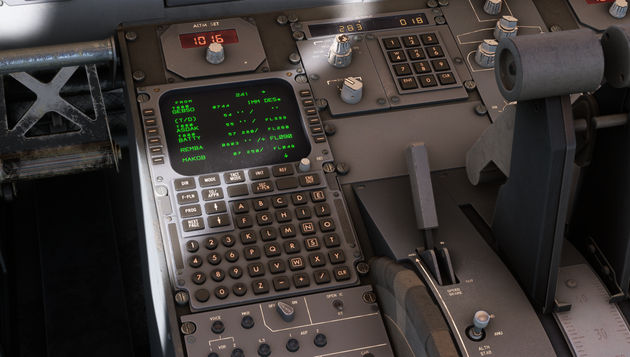
During the descent, multiple indications relating to the descent profile are present on the Navigation Display, such as the “T/D” marker, a “I/P” marker (Intercept Point) which shows the point where the aircraft will intercept the standard descent profile, and a vertical deviation scale on the right side of the display which indicates how high/low the aircraft is with respect to the standard descent profile. If at any point during the descent the pilot wants to regain some manual control of the aircraft, LVLCH (Level Change) and V/S (Vertical Speed) modes are also available.
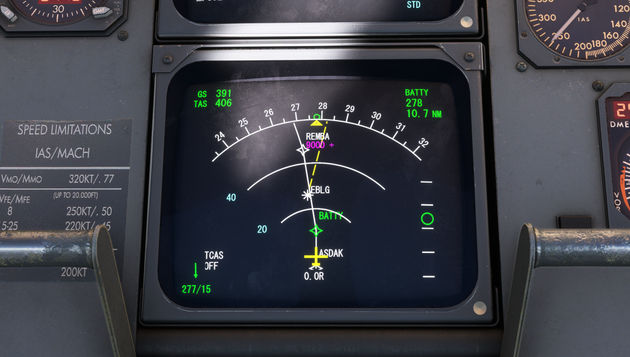
Upon approaching Brussel’s runway 01 with the VHF NAV radios tuned to the ILS frequency and course, the aircraft is now capable of an autoland. With LAND mode engaged and the aircraft in a landing configuration, a LAND 2 annunciator will display at the top of the PFD indicating that the autoland mode is enabled. With both Autopilots and the Autothrottle System all engaged, the pilots can sit back, put their feet up, and let the aircraft do the hard work itself…
Of course we jest, and we need to be extra vigilant when monitoring the instruments and the aircraft’s behaviour, especially whilst the aircraft is still in testing! We currently have the autoland system fully functional and an autoland is possible, but just like everything, we’re still fine-tuning certain aspects.
Upon landing, the lift-dumpers on the upper surface of the wings will deploy automatically, reverse thrust can be selected via levers on the throttles, and the autobrakes will slow the aircraft.
As that now concludes the test flight, all that was left to do was to taxi to the gate, shut down the aircraft, and log some feedback with our development team. A successful test flight isn’t just about smooth operation, it’s about confirming fixes and identifying areas for improvement. This flight met all our criteria and the feedback gathered from these test flights ensures that the product releases as polished as possible on day one.
We're aware this update is text-heavy, but we hope it provided a valuable and engaging look into the progress we’ve made. The F70 Professional and F100 Professional represent our most ambitious projects to date, involving one of our largest development teams and a complex array of systems and features. We’re incredibly proud of how far we’ve come and are excited to share more soon. Thanks for reading!
05 March 2025
Welcome to the next Development Update for our F70/100 Professional for MSFS.
Since our last update, the team has been busy implementing the rest of the basic aircraft systems such as the lift dumpers, airbrake, and the external and cockpit lighting, including new artwork for the F100’s LCD display backlights. These might be only small details but they certainly make a big difference to the overall feel.
Most recently, much of our time has been spent on the more complex systems of the F100, related to the electronic flight information system (EFIS). A major milestone is the inclusion of the Flight Warning System (FWS). This monitors aircraft systems for both normal and abnormal situations and displays various levels of memos, alerts, status messages, and procedures on the centre screens known as MFDUs.
We’ve also started in-depth testing of the F100’s equally complex and very capable autopilot (AFCAS) and FMS. Testing this is a time-consuming process because many different scenarios need to be tested to ensure everything is working across all areas of the flight envelope. There’s nothing more unsatisfying than when the aircraft nose-dives into the ground at the end of a 2-hour flight. Ask us how we know!
With all of these systems coming together, we have now entered a period of intensive testing and bug fixing, with our expert team of F100 pilots and engineers now involved. The nature of a modern aircraft such as the F70/F100 means that testing will continue for a while yet, as a seemingly endless number of combinations of situations and scenarios need to be covered.
As the systems on the F100 mature, we will soon be turning our attention to the F70. This will require some changes to the cockpit panels and tweaks to the flight models to account for the shorter aircraft’s lower weights, different geometry, and slightly different engine performance.
Finally, coming up in the next month will be the integration of the sounds from Sim Acoustics. The whole team cannot wait to get our hands on this, and we’ll be keen to share videos with you once everything is in place. You can read Mike’s experience recording those sounds from the real aircraft in one of our previous in-development updates.
We’ll delve deeper into the systems when the time comes. For now, please enjoy the following set of screenshots taken on a test flight with a recent build.
18 December 2024
Welcome to the next of our updates covering out F70/100 Professional.
As we reach the end of the year, we have achieved some exciting milestones with the F70/100 Professional project. In the cockpit, our coders have been hard at work integrating the F100’s complex systems. The systems are currently about 80% complete and we will be kicking off beta testing in the coming weeks. Fortunately we have a great testing team to help us, full of eager real world F70/100 pilots, engineers and knowledgeable simmers, ready to pick through every single detail. We’re sure that they will keep us on our toes with suggestions, helping to deliver an incredible product. We’ll of course bring you some specific development updates in due course, but for now please enjoy these screenshots of the cockpit, ready for takeoff.
Since our last F70/100 preview, showing off the new HD base textures, our livery artist has been busy upgrading all liveries to 8K resolution. This task isn’t simple due to the challenge of finding high-resolution reference photography, especially for older liveries, particularly important given the level of texture detail that needs to be achieved for such high resolution artwork. With this work also drawing to a close, we hope that you’ll agree that the results are absolutely stunning and will put the F70/100 Professional in good stead for the future. With regards to MSFS 2020 and 2024 compatibility, it’s still early days for MSFS 2024 and so core development is continuing in MSFS 2020 for now, whilst we wait for greater stability. We remain committed to supporting both simulators.
The F70 and F100 will be our next airliner releases for MSFS, coming in the first half of 2025, so look out for more details coming early in the new year.
27 September 2024
It’s been a while since our last update, but the development of the Just Flight F70/100 Professional has been progressing nicely. We will soon be in a position to show you how we’re progressing with the systems, but we aren’t quite there yet. Good things come to those who wait!
So, in the meantime, with Microsoft Flight Simulator 2024 knocking at our door, our artist has been able to spend extra time to give the exterior a much-needed upgrade.
The external textures have been totally redrawn using 8K textures, allowing for much higher fidelity and fine detail. Rivets and screwheads are now clearly visible and vary individually where paint has been applied unevenly or is weathered. The fuselage skin now has a subtle ripple effect, visible in certain lighting conditions, indicative of an aircraft that has seen many pressure cycles in its career. Decals have also been brought up to a higher standard, allowing you to get as close as possible without losing clarity. We’ve also added options such as bare metal cargo door latches and window frames which can be seen on specific aircraft. We will let the screenshots do the talking, but we hope you find the new textures as stunning as we do. This means our other artist is now busy adding extra fine detail to the liveries, and we can’t wait to show you in a future update.
Until next time...
08 May 2024
Following on from last week’s look at some of the F100 liveries, we're now excited to show you, for the first time the F70, but first a bit of background on the aircraft.
After the successful launch of the F100, in the early 90’s the company identified a potential gap in the regional aircraft market. The result was the F70 - a shorter version of the F100, reducing capacity to accommodate 80 passengers. The F70 prototype, which took its inaugural flight on February 2, 1993, started out as an F100. However, it underwent significant modifications, including the removal of several fuselage sections, resulting in a 15.2ft shorter aircraft. The prototype F70, known as PH-MKC, is one of the nine liveries that will be featured on our F70, adorned in the classic Fokker house scheme.
Whilst the F70 shares the same wing design as the F100, the eagle eyed will notice a small change to inboard flap track fairings. These were shortened to facilitate access to the rear cargo door, which is positioned slightly closer to the wing’s trailing edge. Internally you’ll find the cabin is largely identical to the F100 with fewer seat rows and only one emergency exit on each side. Look out for cockpit and systems differences in later development updates though.
Ultimately, the F70 didn’t achieve the same level of popularity as the F100, with only 47 units produced during its brief production period. Despite this, much like its larger counterpart, the aircraft still made its mark globally. As of now, approximately 34 of these aircraft remain in service, with Alliance Airlines in Australia being the largest operator. To represent its diverse service history, our F70 will include the following liveries:
• Alliance Airlines – VH-NUO
• America West – N528YV
• Austrian Airlines – OE-LFH
• Fokker Services (House) – PH-MKC (Prototype)
• KLM Cityhopper – PH-KZL
• Malev Airlines – HA-LMC
• Netherlands Government – PH-KBX
• TUS Airways – 5B-DDF
• Tyrolean – OE-LFK
Enjoy this latest set of screenshots. More to follow soon!
03 May 2024
Since our last update, amongst other things we have been busy bringing our F100 to life by implementing the Hydraulic, Flight Control, and Landing Gear Systems, as well as refining the flight and engine model for the utmost accuracy. With these in place, some tweaking will be required, but we are excited to show functioning displays for the first time. Next up, we’ll be moving onto the autopilot and autothrottle systems. We will, of course, give you more in-depth updates on the systems when the time is right.
On the artwork side, our artist has been busy recreating in meticulous detail a selection of liveries to represent the F100’s extensive service life.
Today, fewer than a third of the entire fleet is still operational, mainly found in the southern hemisphere for the likes of QantasLink, Virgin Australia, and Alliance. Many of those aircraft started out life in the early 1990s with American Airlines, which had a strong fleet of 75 aircraft painted in the classic and much-loved bare metal livery. Naturally, we have to include this.
As well as being a workhorse of short-haul operations in Europe for the likes of KLM, many F100s passed through multiple operators into all corners of the world, sporting a wide range of colourful liveries. We are keen to represent each era of operations, so we will include a stunning variety of 18 liveries. These are:
• Air Berlin – D-AGPB
• Air France Regional – F-GPNK
• Air Niugini - P2-ANH
• Air UK – G-UKFG
• Alliance (90th Anniversary of the first transpacific flight) – VH-FGB
• American – N1473K • British Midland – G-BVJD
• British Airways/TAT – F-GIOA
• Carpatair – YR-FZA
• Fokker Services (House) – PH-LXD
• Germania – D-AGPJ
• Helvetic – HB-JVG
• KLM UK – G-UKFE
• QantasLink – VH-NHA
• Slovak Government – OM-BYV
• Spanair – EC-JJM
• TAM – PT-MQS
• Virgin Australia – VH-FNR
We hope this might inspire you to start planning the wide variety of interesting routes that you’ll be able to fly with the F100 Professional! Pretty soon we'll be showing off the the F70 for the first time. Enjoy the shots!
19 January 2024
In our first F70/F100 In-development update of the year, we wanted to showcase a significant milestone that has just been reached in the project.
When developing an aircraft for any flight simulator, one of the most difficult aspects is getting access to a real aircraft for sound recording. With older aircraft types, this can be easier as there are some very dedicated and helpful museums that preserve their aircraft and allow us to record sounds. This will allow us to record sounds such as switches, levers and doors, and sometimes, even record systems that may be operational. But in most cases, we won’t be able to record engine sounds from these aircraft as the engines are likely no longer functional, or may not be fitted to the aircraft at all, so the engine sounds have to be sourced via other means.
With modern aircraft types, especially rarer ones, it becomes even more difficult to be granted access to an active aircraft, and it is incredible unlikely we'll be given full access and permission to place a selection of microphones around the aircraft during a full power engine run. Well, we are pleased to announce that after years of perseverance, our partners at SimAcoustics have done just that. In the first few weeks of 2024, they were granted access to record an engine run of the type’s last operational aircraft in Europe!
Mike at SimAcoustics shares his experience of the day below:
“In the previous year(s) several attempts were made to organise a recording of a real Fokker 70/100. In the final few months of 2023 things started to move in the right direction and at the start of 2024 we were provided the opportunity to attend a maintenance run up at Woensdrecht/Hoogerheide (The Netherlands).
Packed with our recording equipment we arrived at the crack of dawn. To our utter amazement we found not 1, not 2, but 3 Fokker jets all being lined up for engine runs! As the Fokker jets are no longer being operated in passenger service in Europe (the final operator retiring their jets in the final few months of 2023), witnessing this event alone was already extraordinary.
Conditions were challenging for the aircraft and equipment alike as the temperature was around the level of freezing, with chilling north-eastern winds and occasional snowfall to boot! While setting up the recording equipment the engines of the Fokker 70 were being de-iced as that would be the first aircraft to run. Fortunately the de-icing procedure all worked out and with the fan blades now clean, final checks were made by the crew and all was ready to go. The RR Tay 620s gently started up and as RPMs increased the engine produced that typical and very recognizable jet whine. As this was a low power engine run, we couldn't capture the fan noise just yet... but that would get sorted soon enough.
In the afternoon the weather cleared up a bit and the Fokker 100 was prepared to run. With the equipment largely in place and perhaps aided by a bit of sunshine, preparations went much faster. Interesting to note here is that starting up the RR Tay 650 sounds very different from the 620 we heard just before, as the introduction of fuel into the 650's turbine happens in stages. After the engine was properly warmed up, we were treated to the full power band, the roar of the fan being especially impressive!”
So there we have it. We now have brand new, high-quality engine recordings of the F70 and F100! Following on from the Vulcan, F28, and 146, each with their own critically acclaimed sound sets, the F70/F100 has a lot to live up to, but we are sure it will not disappoint!
Below are couple of photographs taken by SimAcoustics on the day of the sound recording, and a teaser of one of the large selection of liveries that our livery artist has been busy creating for the F70 and F100. More information on those in a future in-development update!
19 December 2023
In our previous F70/100 Professional Dev entry, we focused on the exterior and cabin. However, this doesn’t mean we haven’t been busy at the business end. In fact, the entire cockpit has been completely revamped for the next generation.
Using new reference photographs from an in-service aircraft, the cockpit has been totally reworked with brand new high-resolution textures. Using cutting-edge techniques, we bring you an unprecedented amount of detail right down to individual screw heads and authentic wear and tear, representative of a well-used but serviceable aircraft from the real world. Many hours have been spent color-matching the various parts of the cockpit and tweaking the materials to give an authentic feel. As with our previous aircraft, the textures will be shipped at both standard and high detail, which you will be able to choose depending on your system specifications.
It’s not only the textures which have received a refresh. Dozens of switches and knobs have been totally remodeled to give the highest levels of detail. Extra detailing has been added to the LCD bezels, and the CRT screens have been reworked to give an authentic curved look which will take you straight back to the late 80s when the aircraft first entered service.
Work continues with animating switches and instruments, tweaking lighting, integrating systems, and general bug fixes.
We look forward to sharing more progress of the Just Flight F70/100 Professional in 2024.
30 November 2023
It’s been quite some time since our last Development update for our F70/100 Professional, but that’s not because work has ceased on the project. Quite the opposite in fact!
During the last few months, we have made significant improvements to the interior and exterior modelling and texturing, performance optimisation, as well as making some important progress on the systems coding. There are a lot of features we would like to cover and to give each area its own time to shine, we’ll split the improvements into various updates over the coming weeks and months.
In this update we will be covering the various door configurations and virtual cabins of the F100, and yes the use of plurals isn't a typo!
The F100 will come in the following variants: 1. Folding L1 Passenger Door with Integral Airstairs, Small Cargo Doors 2. Folding L1 Passenger Door with Integral Airstairs, Large Cargo Doors 3. Sliding L1 Passenger Door, Large Cargo Doors 4. Sliding L1 Passenger Door, Small Cargo Doors, Additional L2 Service Door.
Each of these door configurations are included in the product and are modelled on both the interior and exterior. Like our implementation in the F28 Professional, the cabin doors are also interactable from inside the cabin. One difference between the F28 and F100 is the way the doors are operated. In the F100, the L1 passenger door can be operated by means of pushbuttons on the panel above the door.
Some F100s were also fitted with an additional L2 service door just aft of the wing on the port (left) side of the fuselage with the purpose of speeding up turnaround times by allowing catering and cleaning services to access the aircraft as passengers deboard the forward L1 door. The door could also be used for passenger boarding and de-boarding. We have also modelled this configuration on both the interior and exterior which makes the cabin look significantly different, with an additional cabin attendant position and small peep-hole window beside the L2 service door.
All cabins are configured in a high-density 2+3 configuration, and they currently feature seats with a grey leather moquette, white headrests, and a blue carpet, representing a generic F100 cabin. You will, however, be able to be customise all these areas via the included paint kit, and we are also looking into supplying custom cabin colour schemes with the product’s included liveries.
A popular feature of our F28, the music reproducer, also features in the F100. The basic modelling and texturing of the panel is featured in the current build, with the finalised artwork and systems coding to come in the following months. We have a lot of fun ideas for this panel, and we want to take it up a notch from our implementation in the F28. We’ll share more information soon.
With the cabin models and door configurations now in the simulator, we can start working on polishing these areas, including fine tuning the artwork, and improving areas such as the cabin lighting, before then looking at implementing all these features into the F70.
We do hope this update and the attached screenshots have helped scratch an itch in providing an insight into what work we have been doing in the past few months. We look forward to sharing more in-development content in the coming weeks and months.
12 January 2023
We're excited to be able to bring you our first full development entry for our Fokker 70 & 100 following the product announcement last year.
For the 100 variant, the cockpit and exterior models and textures and liveries are currently undergoing extensive testing. We’ve just finished adding all the dynamic cockpit and exterior lighting, and work will soon begin on the Fokker 70 variant and detailed passenger cabin.
We’ll bring you updates on those and the systems coding work in future In Development entries. For now enjoy this initial batch of WIP screenshots.


